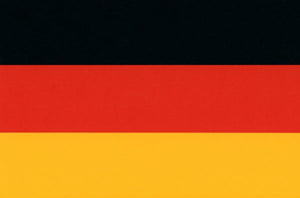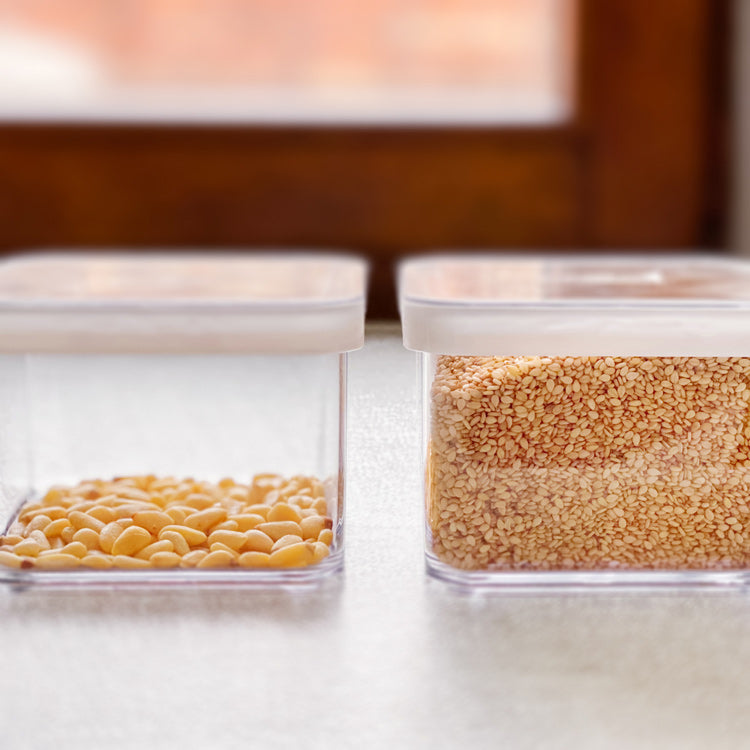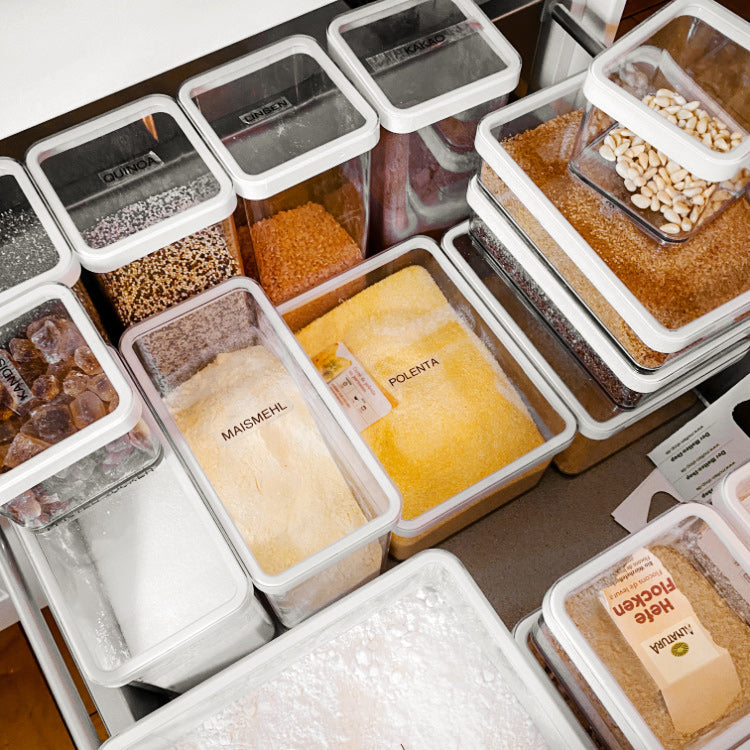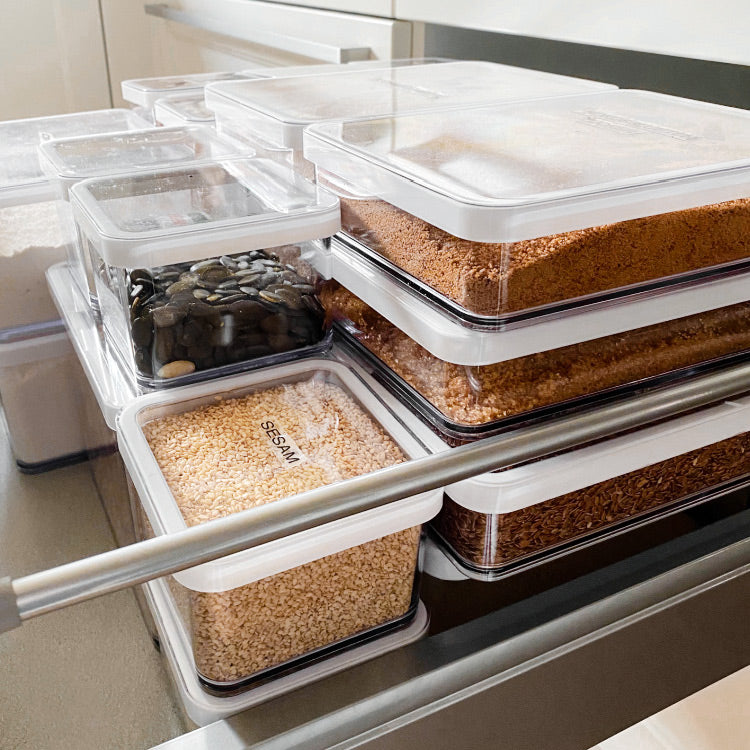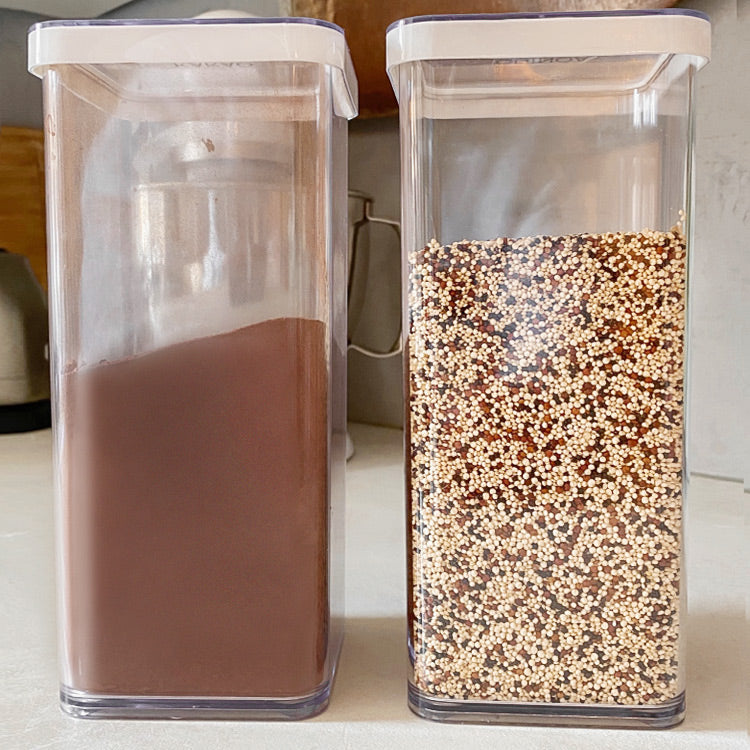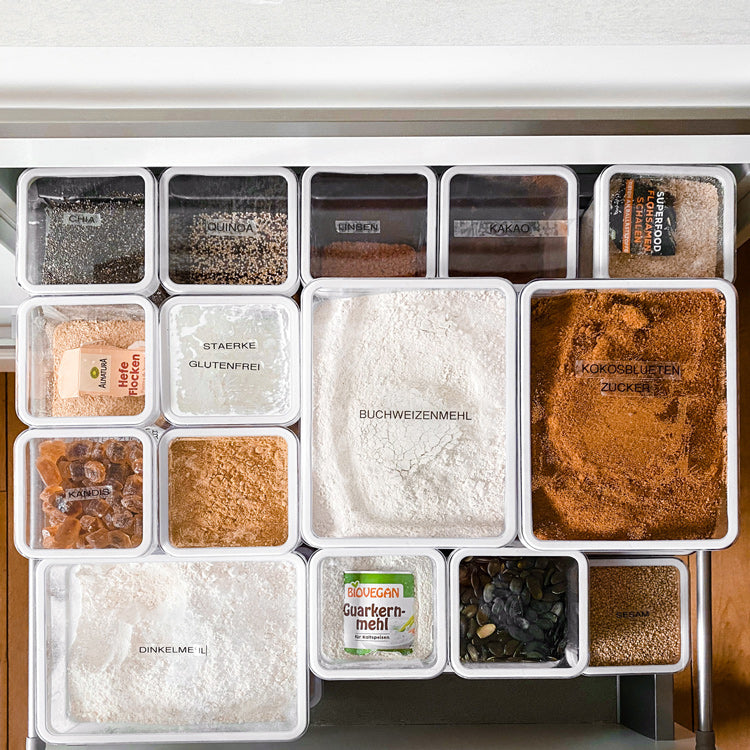Talk about your brand
Anyone who spends time on Pinterest or Instagram will know them: the perfectly organized pantries, filled with shelves with matching containers. Well organized food and uniform labels, without the slightest presence of a cardboard box or plastic bag. We all love these images. But the image is only one aspect.
Why should you place food in a container?Why not put boxes of cereal, pasta and baking powder directly on the pantry shelf? Decanting food into containers is the first way to get rid of the obvious mess. Look in your pantry and you will find that there is hardly a package or jar of the same size. So it's difficult to stack them neatly. And there are packages (for example cornflakes) that have another bag in the cardboard packaging. It's a waste of space!
The overview : Let's stick with the example of cornflakes packaging: who has never had the experience of returning from shopping and finding only a small remnant of cornflakes in the package the next morning? If we put them in transparent packaging, we will always know how much is left.
Why not put boxes of cereal, pasta and baking powder directly on the pantry shelf? Decanting food into containers is the first way to get rid of the obvious mess. Look in your pantry and you will find that there is hardly a package or jar of the same size. So it's difficult to stack them neatly. And there are packages (for example cornflakes) that have another bag in the cardboard packaging. It's a waste of space!
The overview : Let's stick with the example of cornflakes packaging: who has never had the experience of returning from shopping and finding only a small remnant of cornflakes in the package the next morning? If we put them in transparent packaging, we will always know how much is left.
Longer life and fewer insects . Placing food in airtight containers extends its shelf life. Furthermore, unwanted guests such as worms or moths, which can easily find their way through paper bags, are avoided. When decanting, you can already see if the package left the store with parasites (which is not so rare) and you can replace it directly.
Easier use : decanting into containers not only helps you keep track of the quantity, but also makes it easier to use the food. It's much easier to spread flour from a container than from a torn bag that can't be resealed properly.
The best container Home storage containers must meet three criteria: they must be transparent, close well and make the most of cupboard space.
Number 1: why transparent? In a transparent container it is possible to immediately see the inside and also the quantity of food contained. It's simple to cut out the expiry date (BBD) from the packaging and stick it on the container with tape. If you're in a hurry and don't want to write on more stickers, this can also be useful: cut out the package lid or food bag label and simply place it on top. The transparent lid allows you to easily read everything. If you want to label the containers on the side, for example because they will be displayed on a shelf, simply slide the label onto the inside of the container wall. The food will automatically hold it in place.
Home storage containers must meet three criteria: they must be transparent, close well and make the most of cupboard space.
Number 1: why transparent? In a transparent container it is possible to immediately see the inside and also the quantity of food contained. It's simple to cut out the expiry date (BBD) from the packaging and stick it on the container with tape. If you're in a hurry and don't want to write on more stickers, this can also be useful: cut out the package lid or food bag label and simply place it on top. The transparent lid allows you to easily read everything. If you want to label the containers on the side, for example because they will be displayed on a shelf, simply slide the label onto the inside of the container wall. The food will automatically hold it in place.
Number 2: Hermetic seal. Keyword food moths: it is clear that the more airtight the lid, the greater the protection from moths. This also prevents moisture from penetrating and everything remains perfectly dry and fresh.
Number 3 : Make the most of the cupboard . Large vases are often very beautiful, but due to their round shape they do not make the best use of the space. Replacing pots with square containers saves around 20% space. Furthermore, square containers are easier to stack and combine with each other.
The main question is: which containers do I need and which ones are suitable for the right place?In fact, this topic is really exciting. When we go shopping, food products are usually indicated in grams and the size of jars are indicated in litres. How can these data be reconciled? Now do I have to convert my kilo of flour into liters? It's like water: 1 kilo equals 1 liter? Unfortunately it's not that simple. Unfortunately, a kilo of flour is not equivalent to a liter of volume. And 1 kg of coffee beans takes up a completely different space. Why not place the packages of a liter of milk, a packet of flour (1 kg) and a kilo of coffee beans next to each other? This is the best way to see the differences. To calculate the space required by a food, the mass density is necessary.
In fact, this topic is really exciting. When we go shopping, food products are usually indicated in grams and the size of jars are indicated in litres. How can these data be reconciled? Now do I have to convert my kilo of flour into liters? It's like water: 1 kilo equals 1 liter? Unfortunately it's not that simple. Unfortunately, a kilo of flour is not equivalent to a liter of volume. And 1 kg of coffee beans takes up a completely different space. Why not place the packages of a liter of milk, a packet of flour (1 kg) and a kilo of coffee beans next to each other? This is the best way to see the differences. To calculate the space required by a food, the mass density is necessary.
Better to buy a little biggerThe following consideration is important: what do I want to transfer and how much? If you only bake once a year and store a packet of flour, you need a smaller container than if you bake cakes twice a week. Then the container should be twice as large to be able to store more.
And another suggestion: I refer to the example of coffee. 500g of ground coffee has a volume of 0.9 litres. So one sachet would fit great in a liter container. But how do you do it in real life? Ideally, coffee is purchased when the jar is not yet completely empty. This way there is still some left and the new package is filled. In most cases, the new coffee fits exactly into the can. Don't do it. No, let's be honest: it never works and so there's always some coffee left in the bag, which then flies into the cupboard for days.
So when it comes to foods that barely fit in a jar, it's best to go the next size up. In this case, it is a 1.5 liter can.
The following consideration is important: what do I want to transfer and how much? If you only bake once a year and store a packet of flour, you need a smaller container than if you bake cakes twice a week. Then the container should be twice as large to be able to store more.
And another suggestion: I refer to the example of coffee. 500g of ground coffee has a volume of 0.9 litres. So one sachet would fit great in a liter container. But how do you do it in real life? Ideally, coffee is purchased when the jar is not yet completely empty. This way there is still some left and the new package is filled. In most cases, the new coffee fits exactly into the can. Don't do it. No, let's be honest: it never works and so there's always some coffee left in the bag, which then flies into the cupboard for days.
So when it comes to foods that barely fit in a jar, it's best to go the next size up. In this case, it is a 1.5 liter can.
Not sure about the size Flour is a good example of a product that is sold by almost all manufacturers in a 1kg format in a paper bag. But the discussion already stops at semolina: You can find everything, from kilo packs to 300 g cans. If the food is sold in kilos, pounds and half pounds (1000g, 500g, 250g), you can quickly count on the table and find the right container. But there are products that do not fit into any scheme. Neither of comparable size nor of packaging units.
Then the only useful thing is to try: Simply insert the package into the selected container. If the lid can be closed comfortably, then it is quite easy.
Comparing similar foods is also helpful: cocoa powder has a similar density to flour, ginger and nutmeg are similar, and lentils and rice fit in a 1.5-liter container per kilo.
Flour is a good example of a product that is sold by almost all manufacturers in a 1kg format in a paper bag. But the discussion already stops at semolina: You can find everything, from kilo packs to 300 g cans. If the food is sold in kilos, pounds and half pounds (1000g, 500g, 250g), you can quickly count on the table and find the right container. But there are products that do not fit into any scheme. Neither of comparable size nor of packaging units.
Then the only useful thing is to try: Simply insert the package into the selected container. If the lid can be closed comfortably, then it is quite easy.
Comparing similar foods is also helpful: cocoa powder has a similar density to flour, ginger and nutmeg are similar, and lentils and rice fit in a 1.5-liter container per kilo.
Plan intelligently If you want to move your food, you not only have to carefully consider which things you want to store in a can and how many you have, but also what your space needs are. The first question is: where are the containers located? In a drawer? In a closet? On a shelf? How high can the jars be stacked?
Regardless of whether it is a drawer or a wardrobe, the first thing to do is observe the space on the floor and measure it precisely. Once the measurement (length x width) has been calculated, you can understand how many jars can be placed next to each other. This is relatively easy, because all LOFT boxes have a base area of 10 cm (10×10 cm, 10×20 cm, 10×15 cm). You can draw the boxes on a sheet of square paper and calculate your needs. But be careful not to make too tight plans! The jars have a slightly protruding edge at the top and you still need to be able to grasp it to lift it.
Then you can plan the height. Depending on the depth of the drawer or the height of the shelf/cabinet and the need for different sizes, you can see which jars you need. Since the LOFT boxes can be stacked wonderfully in terms of size, you can also work with different sizes. For drawers, jars should be labeled from the top, for cabinets and shelves from the side.
If you want to move your food, you not only have to carefully consider which things you want to store in a can and how many you have, but also what your space needs are. The first question is: where are the containers located? In a drawer? In a closet? On a shelf? How high can the jars be stacked?
Regardless of whether it is a drawer or a wardrobe, the first thing to do is observe the space on the floor and measure it precisely. Once the measurement (length x width) has been calculated, you can understand how many jars can be placed next to each other. This is relatively easy, because all LOFT boxes have a base area of 10 cm (10×10 cm, 10×20 cm, 10×15 cm). You can draw the boxes on a sheet of square paper and calculate your needs. But be careful not to make too tight plans! The jars have a slightly protruding edge at the top and you still need to be able to grasp it to lift it.
Then you can plan the height. Depending on the depth of the drawer or the height of the shelf/cabinet and the need for different sizes, you can see which jars you need. Since the LOFT boxes can be stacked wonderfully in terms of size, you can also work with different sizes. For drawers, jars should be labeled from the top, for cabinets and shelves from the side.
And another tip: Always leave a small space in the drawer or on the shelf to store small food scraps (those that no longer fit in the can, for example) or seasonal nutrients (for example in Christmas desserts) that do not have their own container.
Always leave a small space in the drawer or on the shelf to store small food scraps (those that no longer fit in the can, for example) or seasonal nutrients (for example in Christmas desserts) that do not have their own container.

